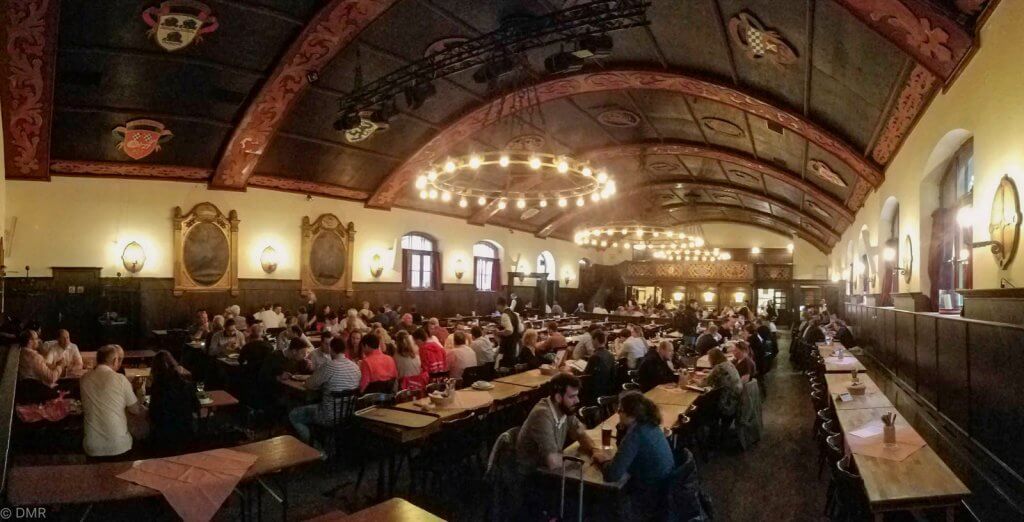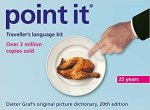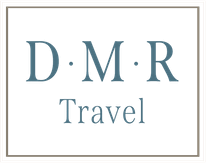
Eating in a foreign language.
I’ll always encourage you to be bold when eating in a foreign country, but I know it can be intimidating reading a menu in a foreign language and not knowing what you’ll get. When I was first learning German and translating a menu, I could read that the words were ‘pork and potatoes’, but how it would be prepared and served would be a surprise.
Imagine you didn’t speak English, but you saw ‘pork tenderloin and potatoes’ or ‘pork chop and potatoes’ on a menu. Unless there were some specific menu descriptions, most of us would make assumptions based on the type of restaurant or US region we happened to be in. In the South, ‘pork tenderloin and potatoes’ might be roasted or grilled, ‘pork chop and potatoes’ might be fried pork chop and mashed potatoes. In the Midwest, a tenderloin sandwich is fried pork on a bun, a schnitzel sandwich.
Those are all great ways to eat pork, and you’d probably be OK with any of them unless you don’t eat pork.
And that brings me to my most important piece of advice: if you can’t eat something because of an allergy, a moral or religious reason, or you just don’t like it, then learn the word(s) for it in the local language. If you have severe food allergies, you need to know how to spot the ingredient on a menu, learn how to ask about the particular food, and learn to understand the answer.
Learning a language is difficult, and if you’re traveling to more than one European country, you’ll need to know several, so have a print-out of your food restrictions in the local languages so that you can show it to the restaurant staff and communicate your needs. Use a piece of paper (have several in case you lose one) with the translation in the local language, not your phone or tablet, in case the waitstaff needs to ask the kitchen staff – they can take the paper, and you don’t have to hand over your phone.
Or use pictures with ‘Point It’ book for travelers.

You’ve probably heard (or read) my recommendation to get out of the main tourist areas to find better food at better prices and avoid restaurants with English menus to get a more authentic meal. But if you don’t speak the language and don’t have someone with you that can translate and order, how can you do that?
1. Use your smartphone.
Download the Google Translate App for Android or iPhone.
A super neat feature of Google Translate is the Instant Translate. In the app, choose the languages you’re translating from and to, then select the camera icon, and then you simply point your camera at the words on the menu, and the translation will show on your phone. Is Google ‘instant translate’ perfect? No, but it is getting better, and it’s a good option when you need a quick translation.
The instant translate gives you a literal translation. If you read my post about Food to Eat in Bavaria, Germany, then you know that sometimes, a literal translation isn’t accurate. For example, Leberkäse directly translated is “liver cheese”, but, in fact, it doesn’t have liver or cheese; it’s a type of meatloaf. So, while this option will help, you might not get what you expected. But did you really want ‘liver cheese’?
You might also want to get a small dictionary in case you’re in a spot where your phone isn’t working. I’ve used the Langenscheidt dictionaries for many years.
2. Learn some of the language.
Find a few menus online with both a German menu and an English menu and start learning a bit.
Sometimes the menu item may not be listed exactly word-for-word or may not be in order, so compare prices to help make sure you’re translating the right menu item.
Augustiner Restaurant Menus:
3. Just ask.
English is widely spoken in tourist areas, and you might be able to simply chat with your server about the menu. There may be some translation issues, but you can work through it. I once ran across a word I could not figure out, and although our server spoke English, it wasn’t a word that he knew how to translate. So he found a piece of paper and started drawing while I guessed the word. It was a fun game!
4. Take a guess and go for it!
If you see another diner eating something that looks interesting, point it out to the waitstaff and order it. Or randomly pick an item on the menu and order it. A good tip is to take a picture of the menu and the item you order so that if you like it, you can look for it again on other menus, or if you hate it, you can avoid it.
Mistakes and miscommunication will happen – just roll with it because that’s part of the travel experience.
More Tips for Dining in Germany
Eat Local!
You’ll see some familiar foods in your travels because most American fast-food restaurants are available around the globe. Having one meal at an American fast-food place can be a fun experience as there are often some interesting differences, but try to keep it to a minimum. After all, you didn’t travel thousands of miles to eat at McDonald’s.
Getting a Seat
In many restaurants, you don’t wait to be seated; you simply find an empty table and take a seat. Also, if the restaurant is busy, and you have empty chairs at your table, don’t be surprised if someone asks if the seats are free, and then shares the table with you. Of course, you can do the same. It can be a fun way to have a conversation with folks.
If you’re in a group of more than 4, it’s best to make reservations.
You Pay for Water
Water will not be free, and ordering tap water is odd, and you’ll get weird looks. If you want water, and you should drink some when you get a chance to stay hydrated, you’ll need to order it. Bottled water will come in two varieties, sparkling and still. If you want the water with the fizzy bubbles, you’ll order ‘Mineralwasser’ or ‘Wasser mit gas’. If you want plain water, you’ll need to specifically ask for ‘stilles Wasser’ or ‘Wasser ohne gas’. Check the sizes and prices, often the smalls (‘klein’) are pretty small, and the larges (‘gross’) can be a much better value. You probably need the large anyway.
Paying the Bill
Dining out is an event in Europe, and once you’re seated, it’s expected that the table is yours for the evening, and you won’t be rushed out. When you’re ready to pay (or ready to order), you’ll need to get the waitstaff’s attention because the check won’t automatically be dropped at your table. Usually, all it takes is some eye contact and a quick hand wave to get attention. And there’s the universal writing on your hand gesture to say ‘I’m ready to pay’.
If you’re at a sit-down restaurant with table service, payment is made at the table with your server – staff carry money pouches and will complete the transaction at your table.
Cash is the preferred payment method. In smaller towns and mom-and-pop type places, credit cards may not be accepted at all. Most restaurants in the tourist areas of larger cities will take credit cards, but look for the credit card logos or ask the waitstaff if credit cards are accepted before ordering, and make sure you always have cash on you in case you need it.
US credit cards still require a signature, where European cards use a PIN, so you might run into some confusion when paying with your American credit card because they aren’t accustomed to getting a signature. Use Mastercard or Visa because AMEX and Discover cards aren’t regularly accepted.
Tipping
Tipping large amounts isn’t required or expected as it is in the US, but a tip is always appreciated and isn’t as out of place in Germany as it once was. In fact, you might start noticing tip jars on service counters. A 10% tip is customary at a restaurant with table service, and anything over that is generous. Even if you’re paying by credit card, you should tip in cash. If you’re at a restaurant with table service and waitstaff, when you pay, include the tip and hand it to the server, don’t leave the tip on the table when you leave.
If you’re ordering something small, like a coffee or a beer at a cafe, you can round up to the nearest Euro for a small tip.
A Note about Cash:
Use ATMs to get cash and try to find one in a bank for more security. If the bank is closed, and the ATM is inside, look for a card swipe at the front entrance. You swipe your card, and the door will unlock so that you can get inside.
Don’t use traveler’s checks. They aren’t accepted, and finding a way to cash them can be a problem.
Get More Germany Travel Tips
Top 5 Munich Biergartens
Food to Eat in Bavaria, Germany
